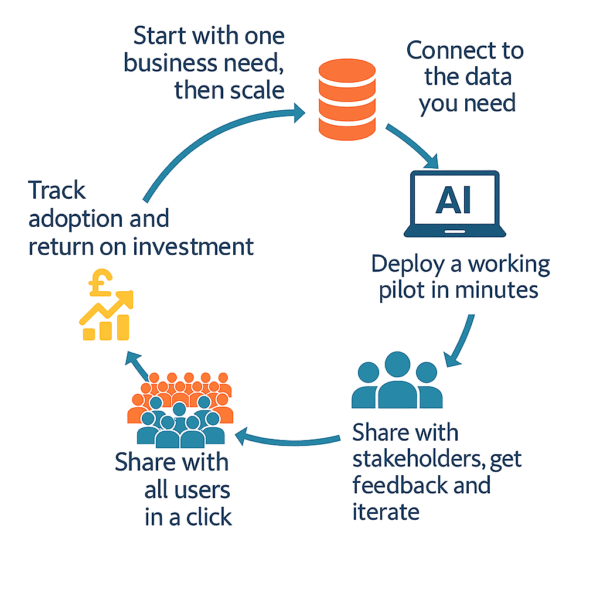By Adam Brown
Stuck in Pilot Purgatory? You’re Not Alone
Have you ever felt like your organisation is perpetually stuck running AI pilot projects, those exciting experiments full of promise that somehow never quite make it into everyday operations? It’s what many in the industry call “pilot purgatory,” a frustrating cycle where ambitions rarely match reality.

The trouble is, scaling AI isn’t just a tech challenge; it’s deeply human, wrapped up in business culture, organisational habits, and good old-fashioned scepticism about change. Big, bold rollouts might sound impressive in theory, but they often crash into harsh operational realities, leaving everyone involved feeling disillusioned. So, how can we tackle this?
Introducing the “Loop by Loop” Approach
At Fujitsu’s Integrated Intelligence event this May, Nina Scheck shared insights on overcoming these hurdles with something she called the “loop by loop” approach. This is an approach that we have advocated for years. It isn’t about flashy, huge-scale rollouts but about small, strategic loops. Think iterative cycles of targeted innovation that deliver clear, measurable value from the start.

By breaking down complex AI initiatives into manageable chunks, you give teams quick wins that are immediately visible. It’s like tackling a massive puzzle piece by piece, with each completed section giving your team renewed energy and motivation to carry on.
In essence, the loop by loop approach looks like this:
– Start Small, Think Big: Pick precise, high-impact problems to solve.
– Move Quickly: Aim for tangible results within weeks, not months.
– Win Trust Early: Clearly show the benefits of AI from day one.
– Adapt Constantly: Refine and improve based on feedback.
– Expand Gradually: Scale using the confidence and insights gained from earlier successes.
Step 1: Choosing the Right Battles
Picking the right initial challenges is crucial. Go for high-impact areas where the improvements are obvious, like predictive maintenance on production lines or pinpoint-accurate retail forecasting. Why these? They provide instant, visible outcomes that not only boost morale but also offer compelling evidence that AI really is worth the investment.
Step 2: Speed Matters, Deploy Rapidly
Quick deployment keeps enthusiasm high and prevents AI initiatives from becoming stale before they even get going. Aim for visible outcomes in a matter of weeks. You know what they say about momentum: once you’ve got it, things start to feel a whole lot easier.
Step 3: Building Trust Through Results
Results build trust; it’s as simple as that. In the world of AI, trust is priceless. Celebrate your early successes openly, but don’t hide your mistakes either. Transparency breeds confidence, and with confidence comes a greater willingness from your team to embrace further AI developments.
Step 4: Learn, Evolve, and Expand Bit by Bit
Each loop is a lesson learned. Use these insights to sharpen your approach, streamline your processes, and win over the hearts and minds of sceptics. Regular feedback ensures your AI projects remain closely aligned with your business strategy and adapt smoothly to daily operational realities.

AI Operationalisation: It’s a Journey, Not a Sprint
Ultimately, making AI part of your daily operations is less about hitting a specific finish line and more about nurturing a culture of continuous improvement. The loop by loop approach doesn’t just deliver results; it builds habits and embeds AI into your organisational DNA.
So, forget about the dramatic “big bang” approach. Real, lasting change comes from ongoing, incremental improvements. Before you know it, those small loops add up to something genuinely transformative.

